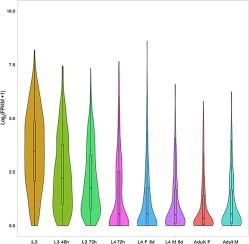International Journal for Parasitology ( IF 3.7 ) Pub Date : 2020-06-25 , DOI: 10.1016/j.ijpara.2020.05.003 James P Bernot 1 , Gabriella Rudy 2 , Patti T Erickson 3 , Ramesh Ratnappan 4 , Meseret Haile 5 , Bruce A Rosa 6 , Makedonka Mitreva 7 , Damien M O'Halloran 8 , John M Hawdon 4

|
Free-living nematodes respond to variable and unpredictable environmental stimuli whereas parasitic nematodes exist in a more stable host environment. A positive correlation between the presence of environmental stages in the nematode life cycle and an increasing number of G-protein coupled receptors (GPCRs) reflects this difference in free-living and parasitic lifestyles. As hookworm larvae move from the external environment into a host, they detect uncharacterized host components, initiating a signalling cascade that results in the resumption of development and eventual maturation. Previous studies suggest this process is mediated by GPCRs in amphidial neurons. Here we set out to uncover candidate GPCRs required by a hookworm to recognise its host. First, we identified all potential Ancylostoma ceylanicum GPCRs encoded in the genome. We then used life cycle stage-specific RNA-seq data to identify differentially expressed GPCRs between the free-living infective L3 (iL3) and subsequent parasitic stages to identify receptors involved in the transition to parasitism. We reasoned that GPCRs involved in host recognition and developmental activation would be expressed at higher levels in the environmental iL3 stage than in subsequent stages. Our results support the model that a decrease in GPCR diversity occurs as the larvae develop from the free-living iL3 stage to the parasitic L3 (pL3) in the host over 24–72 h. We find that overall GPCR expression and diversity is highest in the iL3 compared with subsequent parasitic stages. By 72 h, there was an approximately 50% decrease in GPCR richness associated with the moult from the pL3 to the L4. Taken together, our data uncover a negative correlation between GPCR diversity and parasitic development in hookworm. Finally, we demonstrate proof of principal that Caenorhabditis elegans can be used as a heterologous system to examine the expression pattern of candidate host signal chemoreceptors (CRs) from hookworm. We observe expression of candidate host signal CRs in C. elegans, demonstrating that C. elegans can be effectively used as a surrogate to identify expressed hookworm genes. We present several preliminary examples of this strategy and confirm a candidate CR as neuronally expressed.
中文翻译:

对锡兰钩虫生命周期阶段的转录组分析揭示了与寄生开始相关的 G 蛋白偶联受体多样性的变化。
自由生活的线虫对可变且不可预测的环境刺激做出反应,而寄生线虫则存在于更稳定的宿主环境中。线虫生命周期中环境阶段的存在与 G 蛋白偶联受体 (GPCR) 数量的增加之间存在正相关性,反映了自由生活和寄生生活方式的这种差异。当钩虫幼虫从外部环境进入宿主时,它们会检测到未表征的宿主成分,启动信号级联,从而恢复发育并最终成熟。先前的研究表明这一过程是由两栖神经元中的 GPCR 介导的。在这里,我们着手发现钩虫识别其宿主所需的候选 GPCR。首先,我们鉴定了基因组中编码的所有潜在的锡兰钩虫GPCR。然后,我们使用生命周期阶段特异性 RNA-seq 数据来识别自由生活的感染性 L3 (iL3) 和随后的寄生阶段之间差异表达的 GPCR,以识别参与寄生过渡的受体。我们推断,参与宿主识别和发育激活的 GPCR 在环境 iL3 阶段的表达水平高于后续阶段。我们的结果支持这样的模型:当幼虫在宿主体内从自由生活的 iL3 阶段发育到寄生 L3 (pL3) 阶段时,GPCR 多样性会下降 24-72 小时。我们发现,与随后的寄生阶段相比,iL3 中的总体 GPCR 表达和多样性最高。到 72 小时,与从 pL3 到 L4 的换羽相关的 GPCR 丰富度下降了约 50%。综上所述,我们的数据揭示了 GPCR 多样性与钩虫寄生发育之间的负相关性。最后,我们证明了秀丽隐杆线虫可以用作异源系统来检查钩虫候选宿主信号化学感受器(CR)的表达模式。我们观察了秀丽隐杆线虫中候选宿主信号CR的表达,证明秀丽隐杆线虫可以有效地用作鉴定表达的钩虫基因的替代品。我们提出了该策略的几个初步示例,并确认了候选 CR 是神经元表达的。











































 京公网安备 11010802027423号
京公网安备 11010802027423号